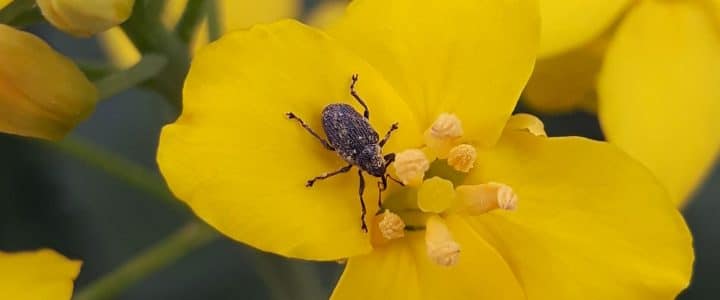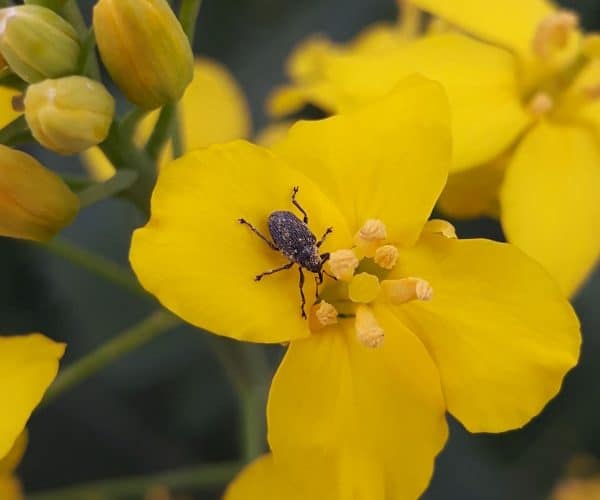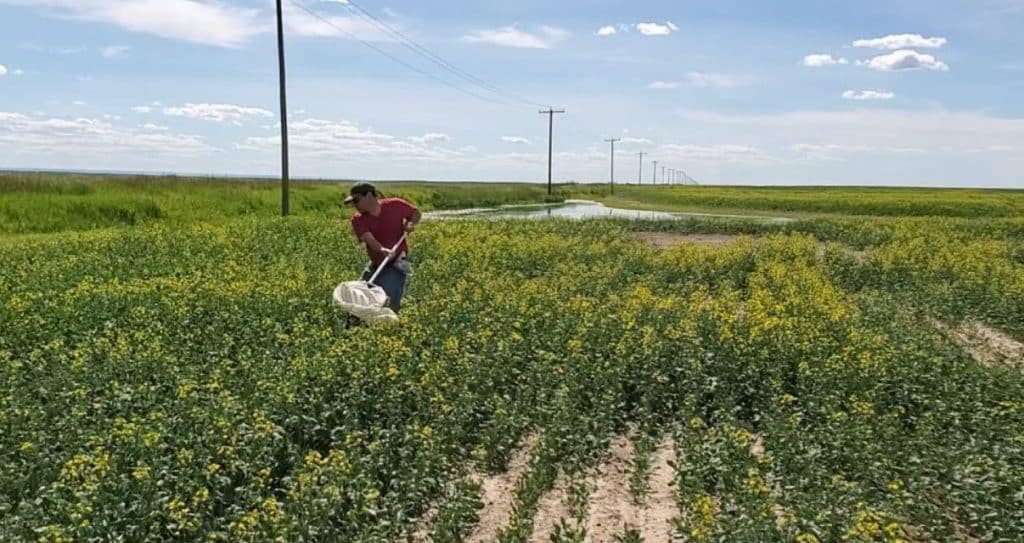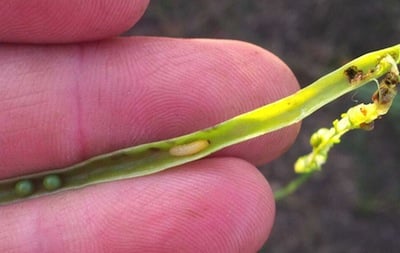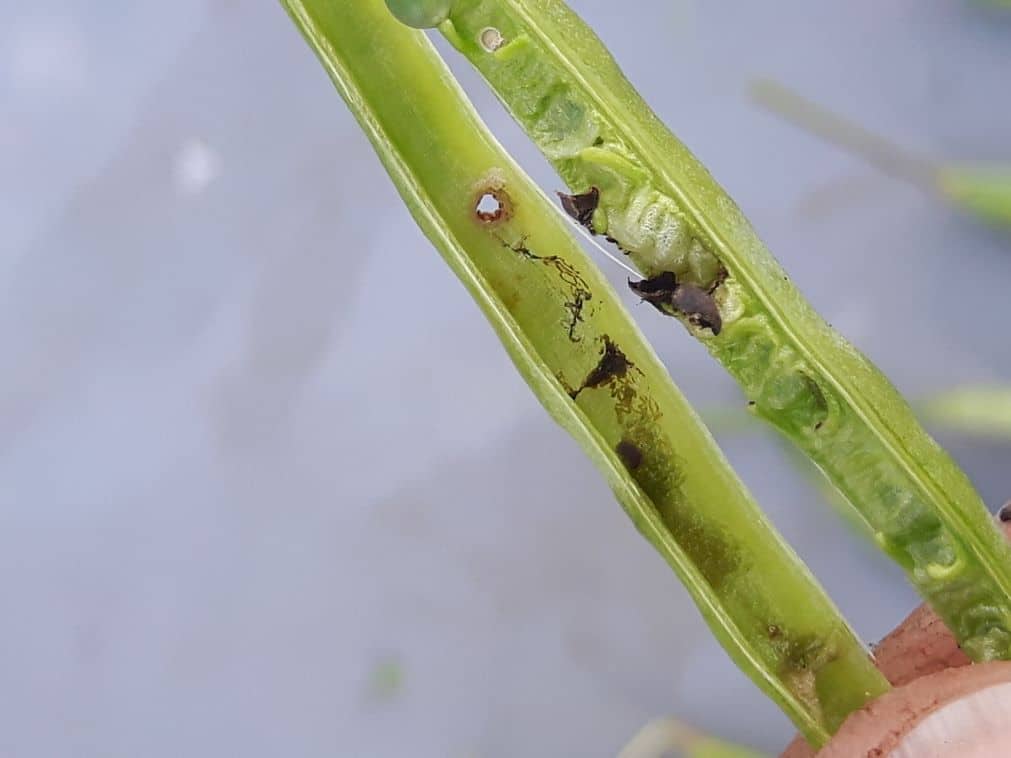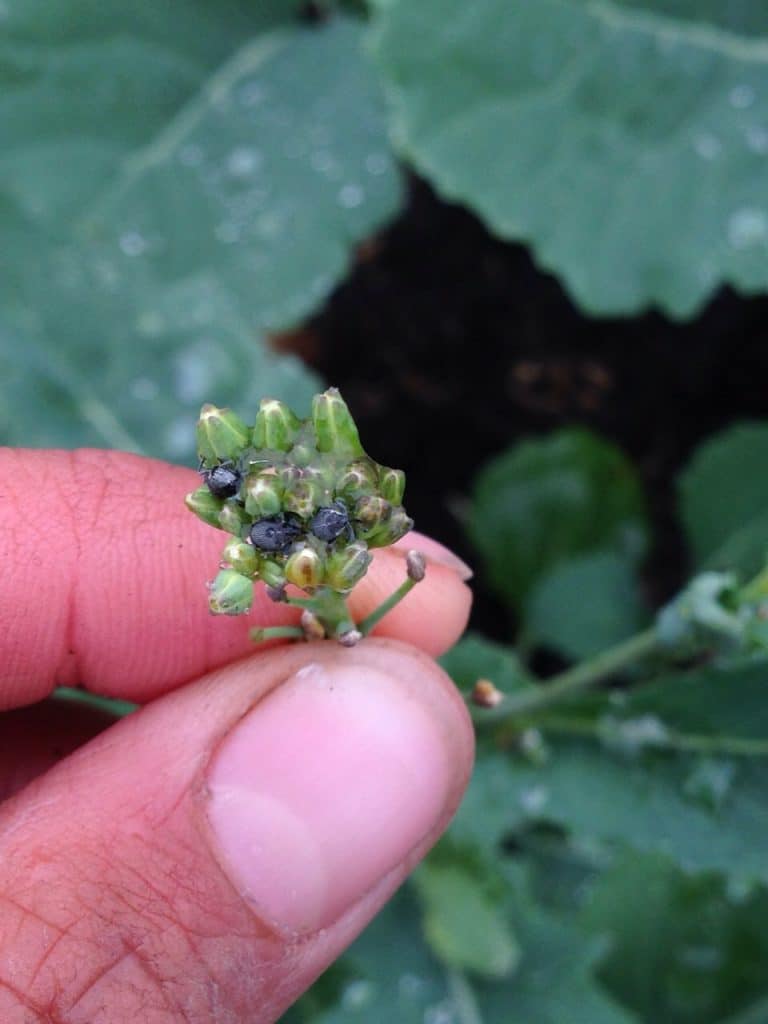The cabbage seedpod weevil, Ceutorhynchus obstrictus (Marsham), which originated in Europe, was first found in British Columbia in the 1930s and has since increased its range into the Prairies. The beetle (from the family Curculionidae) consumes several plants from the family Brassicaceae, including canola (Brassica napus). At high populations, can have a significant impact on yield, making it of interest to many growers and agronomists in the Canadian canola growing region. Read more on this here.
Commencing Canadian cabbage seedpod weevil research
Cabbage seedpod weevil was first reported in Alberta canola fields in 1995. Outbreaks of the weevil in Alberta in 1999 and 2000 prompted the beginning of research on this insect. This included examining the biology of the insect, the impact of it on canola crops and management strategies to monitor and potentially control it in western Canada (where large areas of host crops are grown).
Management recommendations based on cabbage seedpod weevil findings
Dosdall’s Biology and Control of the Cabbage Seedpod Weevil, a New Pest of Canola in Alberta project generated many valuable findings, which could be applied to a number of practices that growers and agronomists can carry out. These include:
- Research finding: Cabbage seedpod weevil emerges from its overwintering sites in April to feed on brassicaceous host plants, such as flixweed (D. sophia), pennycress (T. arvense), wild mustard (S. arvense), volunteer canola (B. napus and B. rapa), and hoary cress (Cardaria spp.). (Note that it was later shared that, interestingly, yellow mustard is not a host plant).
- Corresponding management recommendation: If growers can control weeds early in the season to minimize these brassicaceous host plants weed populations, they will be eliminating an important refuge sites for cabbage seedpod weevil adults.
- Research finding: Cabbage seedpod weevils produce one generation per growing season. Adults will migrate to canola crops at the bud and flowering stages, and can cause “bud-blasting” by feeding on pollen within buds, destroying vascular tissue in the process. The overwintering adults will then mate and lay eggs into small pods, often on the lower regions of canola racemes. When the larvae hatch 6-10 days later, they feed on developing seeds, consuming approximately five seeds, or about 18% of the yield of a pod, during their development. Then the larvae bore through the wall of the seed pod and drop to the soil to pupate, leaving an exit hole behind in the pod (see image below). Approximately 10 days later, a new generation of adults will emerge from the cocoons.
- Corresponding management recommendation (1): Since the larval stage of cabbage seedpod weevil is protected from insecticide applications while feeding within the canola pods, it is most effective to control the (overwintered) adults before they lay eggs. It is very difficult (or nearly impossible) to control the cabbage seedpod weevil larvae, unlike larvae of some other species that feed on canola crops. Furthermore, the short window of time between the arrival of (overwintered) adult cabbage seedpod weevils in a canola field and the laying of eggs emphasizes the need to vigilantly monitor canola crops from the rosette through flowering stages. Early identification of weevil invasion is crucial to making the most informed (and effective) management decisions.
- This AAFC Field Crop Guide and CCC Canola Insect scouting guide can help identify cabbage seedpod weevils.
- Corresponding management recommendation (2): The life stage timing of this insect also highlights the importance of precise application timing (at 10-20% flower, when 70% of the plants have minimum 3-10 open flowers) before the overwintered adults have laid their eggs. The Canola Council of Canada’s Canola Blooming Stages graphic can be used as a guide for determining flowering percentages.
- Corresponding management recommendation (4): Understanding that the adults are mobile prior to laying eggs (which will eventually lead to damage-causing larvae) clarifies the cabbage seedpod weevil life stage that should be scouted for (and which spray decisions are based on). Given that the adults are quite mobile, sweep net sampling is the best method to monitor the overwintering adult populations of cabbage seedpod weevil. Since they invade the crop from the field border, adult weevils are often clumped near the field edges. Therefore, scouting locations should include both the perimeter and inside of the field to obtain the most accurate estimate of weevil numbers throughout the field. See the Investigating potential management solutions section for related trap cropping findings.
- To visualize the scouting method, check out this one-minute Canola Watch video. For more scouting tips, see this article.
- Corresponding management recommendation (5): Since the proper timing to spray the adult stage of the pest insect is in early flower, when pollinators are abundant, it is recommended to use synthetic pyrethroids, which are known to have little residual insecticidal activity (and therefore have less negative impact on pollinators). For specific insecticide options, see a provincial Crop Protection Guide (such as Manitoba’s Field Crop Protection 2021).
- To ensure pre-harvest intervals for insecticide applications are followed, check the Spray to Swath calculator.
- Corresponding management recommendation (1): Since the larval stage of cabbage seedpod weevil is protected from insecticide applications while feeding within the canola pods, it is most effective to control the (overwintered) adults before they lay eggs. It is very difficult (or nearly impossible) to control the cabbage seedpod weevil larvae, unlike larvae of some other species that feed on canola crops. Furthermore, the short window of time between the arrival of (overwintered) adult cabbage seedpod weevils in a canola field and the laying of eggs emphasizes the need to vigilantly monitor canola crops from the rosette through flowering stages. Early identification of weevil invasion is crucial to making the most informed (and effective) management decisions.
- Research finding: Only small populations of cabbage seedpod weevil parasitoids were found and they were suspected to be Microctonus melanopus Ruthe, a European braconid wasp parasitoid. It was recommended that more research be done to identify and evaluate different biological control agents of cabbage seedpod weevil. See the Investigating potential management solutions section below for more research on this topic.
- Corresponding management recommendation: Canola growers can conserve populations of natural cabbage seedpod weevil predators by avoiding insecticide applications where weevil populations don’t exceed the economic threshold.
Based on the biological findings of this insect, Dosdall’s report suggested subsequent research explore control strategies such as trap cropping, fall seeding, altering seeding rates, row spacing and fertility regimes and seeding rates, to determine additional options that could be effective for canola growers.
For tips to use when scouting canola and considerations for growers and agronomists when making decisions and planning control options, see this Canola Watch article.
Cabbage seedpod weevil and lygus bugs
Since lygus bugs and cabbage seedpod weevils are both found throughout the canola growing region, the relationship between these two pest insects has been investigated. The Management of lygus bugs and cabbage seedpod weevils in canola study examined this relationship, but due to one year of data that was impacted by drought, suggested that further research was needed to confirm the results. Cárcamo’s Management of lygus and seedpod weevils in canola at the farm level project reported there was no indication that having the two pests at moderate numbers increased the risk of higher yield losses compared to fields with only high numbers of seedpod weevils.
Interestingly, Cárcamo’s study also reported that the effect of seeding date on lygus bugs was contrary to that of cabbage seedpod weevils. Seeding early in April or early May resulted in greater cabbage seedpod weevil populations (20-40 per sample of 10 sweeps) and lower lygus bug populations. While fields planted in the last two weeks of May had lower cabbage seedpod weevil numbers (<5 per 10 sweeps) and a greater number of lygus (during the pod stage).
Distribution and monitoring
Since cabbage seedpod weevil was first found in the Canadian Prairies, interest in determining its distribution was evident. However, the increase in distribution of cabbage seedpod weevil observed over several years has really highlighted the need for a sustained monitoring effort of the cabbage seedpod weevil. These Prairie Pest Monitoring network maps depict the change in distribution between 2007-2020. For a live snapshot of cabbage seedpod weevil populations in Alberta, see the Alberta Agriculture live, crowd-sourced, cabbage seedpod weevil map. Saskatchewan also produces an annual population and distribution map for this insect.
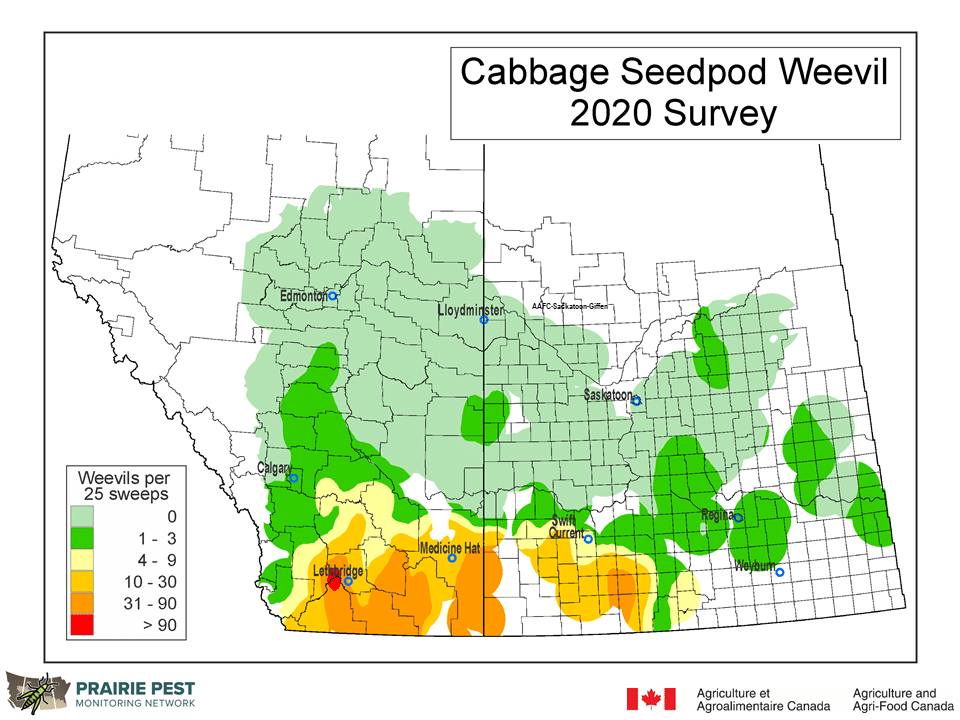
Investigating potential management solutions
- Seeding rate has been investigated separately from lygus too. Dosdall’s Integrated Management of Cabbage Seedpod Weevil and Overwintering Biology of Canola Pests study reported that both earlier seeding dates and increasing seeding rates resulted in greater cabbage seedpod weevil infestation. However, greater seed yields were also produced at higher seeding rates and earlier seeding dates (in this 2001-2004 study), suggesting that canola can compensate for attack by this pest.
- Unfortunately, it has also been reported that adult feeding damage can be more evident in dry years when canola is unable to compensate for bud loss.
- Utilizing the knowledge of the cabbage seedpod weevil pest invading from field edges and following Dosdall’s earlier recommendation, further investigation has been done on trap cropping. Integrated Management of Cabbage Seedpod Weevil and Overwintering Biology of Canola Pests reported that planting canola which flowered earlier than the main crop was an effective way to concentrate cabbage seedpod weevil adults, so that growers could spray just the field borders instead of the full field. It was also noted that growers still reported an economic benefit when two border sprays were required for adequate weevil control. An additional benefit was that damage to non-target and beneficial insect species was minimized with this approach.
- Although only small populations of parasitoids were reported in Dosdall’s earlier research, the Integrated Management of Cabbage Seedpod Weevil and Overwintering Biology of Canola Pests study resulted in the discovery of a parasitic wasp species Trichomalus perfectus (Walker). Previously unknown to Alberta, this beneficial insect attacks cabbage seedpod weevil larvae that are feeding within pods. Microctonus melanopus Ruthe, the parasitoid that attacks adult cabbage seedpod weevils, was also found in mixed weed patches near Lethbridge, Alberta (during this study) and appeared to overwinter as a larva or embryo.
- To further examine this natural enemy of the cabbage seedpod weevil, the Biological control of cabbage seedpod weevil in the Prairies study is currently underway. This five-year project (2018-2023) will assess the efficacy of Trichomalus perfectus in managing seedpod weevil in Quebec and its non-target effects in Eastern Canada. The research also aims to document the species of weevils and parasitoids in cultivated and uncultivated habitats that could be affected directly or indirectly in the Prairies.
More pest and beneficial insect studies are available on the Canola Research Hub.
Published July 30, 2021


